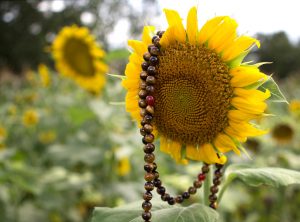If you ask several people, you may receive several different answers. The number 108 is significant for several reasons. Some meditation practitioners believe the journey of the human soul has 108 stages, while others associate the possibility taking just 108 breaths in a day, while in a deep meditation state of enlightenment. We would not recommend one try it.
The best theory we discovered is that the 108 beads on your mala is open to your own interpretation. What is important to you is what matters most. Mala beads were created as a practice tool to use during meditation. While you don’t need mala beads to meditate, most people that use them make it part of their ritual. Mala beads help you to manifest and keep you focused on a mantra. A mala allows one to chant their mantra and keep track of where you are. While many mala necklaces have 108 beads, some contain 54, or half of that amount of beads.
Another explanation for the number 108 is based on Chakras. It is believed there are 108 energy lines connecting to the heart. One of these paths is believed to be the path of self-realization. Others state that while chanting your mantra during meditation you are whole when you reach 100 times. The extra eight beads account for errors or are meant to be an offering to your guru.
Another belief is based on the ancient script of India. Within the Sanskrit alphabet, there are 54 letters. Each has a feminine and masculine version adding up to 108. Other theories evolve around desires, lies and delusions. There are said to be 108 earthly desires in mortals. There are said to be 108 lies that humans tell. There are said to be 108 human delusions or forms of ignorance. Math also points to some theories of the number 108. Nine times twelve; both of these numbers have significance in various traditions, 9 X 12 = 108. The number 108 is also a Harshad number, which is an integer divisible by the sum of its digits. Harshad is from Sanskrit and means ‘great joy’.
The more research you perform, the more ideas and theories you will discover. We fall back to our belief
that whatever is important to you is what matters. Namaste!






